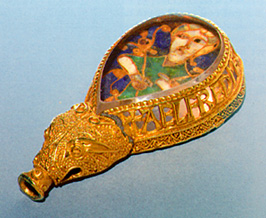
The Alfred Jewel (Ashmolean Museum, Oxford) was discovered in 1693 in Somerset, not far from Athelney where Alfred famously hid out in the marshes during his campaign against the Danes. It appears to be from the late 9th century. The inscription reads 'AELFRED MEC HEHT GEWYRCAN' ('Alfred had me made'). It is not certain that the Alfred of the inscription was the King, but the elegance and richness of the workmanship suggests that this is possible.

The jewel consists of a cloisonné enamelled image of a figure in a hieratic pose, placed under rock crystal, in a filigree gold setting. At the base, the setting becomes an animal head, possibly a boar. There is an empty hole in its nose which suggests that something, a wooden or ivory rod, once protruded from it.
It has been suggested that this is the top of an ęstel, interpreted as 'a pointer', or rule for running down the lines of a book in order to keep a reader's place as they read. The word would then come from Latin *hastellum, or 'little spear'. If this was an ęstel of the kind sent with the copy of the Cura Pastoralis, it was worth 300 sheep.
Another possibility is that it is the head of a staff of offfice of some kind.
Smaller objects of the same kind are:
 | The Minster Lovell Jewel (Ashmolean Museum, Oxford), also dated to the late 9th century, which appears to be a more modest version of the Alfred Jewel, and |
 | the Bowleaze Cove Mount, apparently same date and for the same purpose, though smaller yet. |
Back to previous page.
© MEG TWYCROSS 1998